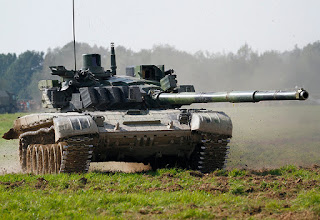Tanks Military
The T-72 has a comprehensive nuclear, biological, and chemical (NBC) protection system. The inside of both hull and turret is lined with a synthetic fabric made of boron compound, meant to reduce the penetrating radiation from neutron bomb explosions. The crew is supplied clean air via an extensive air filter system. A slight over-pressure prevents entry of contamination via bearings and joints. Use of an autoloader for the main gun allows for more efficient forced smoke removal compared to traditional manually loaded ("pig-loader") tank guns, so NBC isolation of the fighting compartment can, in theory, be maintained indefinitely. Exported T-72s do not have the antiradiation lining.
The T-72 is equipped with the 125 mm (4.9 in) 2A46 series main gun, a significantly larger (20-mm larger) calibre than the standard 105 mm (4.1 in) gun found in contemporary Western MBTs, and still slightly larger than the 120 mm/L44 found in many modern Western MBTs. As is typical of Soviet tanks, the gun is capable of firing anti-tank guided missiles, as well as standard main gun ammunition, including HEAT and APFSDS rounds.
Like the earlier domestic-use-only T-64, the T-72 is equipped with an automatic loading system, eliminating the need for a dedicated crewmember, decreasing the size and weight of the tank. More details
The T-72 is a Soviet second-generation main battle tank that entered production in 1971. About 20,000 T-72 tanks were built, making it one of the most widely produced post–World War II tanks, second only to the T-54/55 family. The T-72 was widely exported and saw service in 40 countries and in numerous conflicts.
 The T-72 shares many design features with other tank designs of Soviet origin. Some of these are viewed as deficiencies in a straight comparison to NATO tanks, but most are a product of the way these tanks were envisioned to be employed, based on the Soviets' practical experiences in World War II.
The T-72 shares many design features with other tank designs of Soviet origin. Some of these are viewed as deficiencies in a straight comparison to NATO tanks, but most are a product of the way these tanks were envisioned to be employed, based on the Soviets' practical experiences in World War II.
The T-72 is extremely lightweight, at forty-one tonnes, and very small compared to Western main battle tanks. Some of the roads and bridges in former Warsaw Pact countries were designed such that T-72s can travel along in formation, but NATO tanks could not pass at all, or just one-by-one, significantly reducing their mobility. The basic T-72 is relatively underpowered, with a 780 hp (580 kW) supercharged version of the basic 500 hp (370 kW) V-12 diesel engine originally designed for the World War II-era T-34. The 0.58 m (1 ft 11 in) wide tracks run on large-diameter road wheels, which allows for easy identification of the T-72 and descendants (the T-64/80 family has relatively small road wheels).
 The T-72 shares many design features with other tank designs of Soviet origin. Some of these are viewed as deficiencies in a straight comparison to NATO tanks, but most are a product of the way these tanks were envisioned to be employed, based on the Soviets' practical experiences in World War II.
The T-72 shares many design features with other tank designs of Soviet origin. Some of these are viewed as deficiencies in a straight comparison to NATO tanks, but most are a product of the way these tanks were envisioned to be employed, based on the Soviets' practical experiences in World War II.The T-72 is extremely lightweight, at forty-one tonnes, and very small compared to Western main battle tanks. Some of the roads and bridges in former Warsaw Pact countries were designed such that T-72s can travel along in formation, but NATO tanks could not pass at all, or just one-by-one, significantly reducing their mobility. The basic T-72 is relatively underpowered, with a 780 hp (580 kW) supercharged version of the basic 500 hp (370 kW) V-12 diesel engine originally designed for the World War II-era T-34. The 0.58 m (1 ft 11 in) wide tracks run on large-diameter road wheels, which allows for easy identification of the T-72 and descendants (the T-64/80 family has relatively small road wheels).
The T-72 has a comprehensive nuclear, biological, and chemical (NBC) protection system. The inside of both hull and turret is lined with a synthetic fabric made of boron compound, meant to reduce the penetrating radiation from neutron bomb explosions. The crew is supplied clean air via an extensive air filter system. A slight over-pressure prevents entry of contamination via bearings and joints. Use of an autoloader for the main gun allows for more efficient forced smoke removal compared to traditional manually loaded ("pig-loader") tank guns, so NBC isolation of the fighting compartment can, in theory, be maintained indefinitely. Exported T-72s do not have the antiradiation lining.
The T-72 is equipped with the 125 mm (4.9 in) 2A46 series main gun, a significantly larger (20-mm larger) calibre than the standard 105 mm (4.1 in) gun found in contemporary Western MBTs, and still slightly larger than the 120 mm/L44 found in many modern Western MBTs. As is typical of Soviet tanks, the gun is capable of firing anti-tank guided missiles, as well as standard main gun ammunition, including HEAT and APFSDS rounds.

